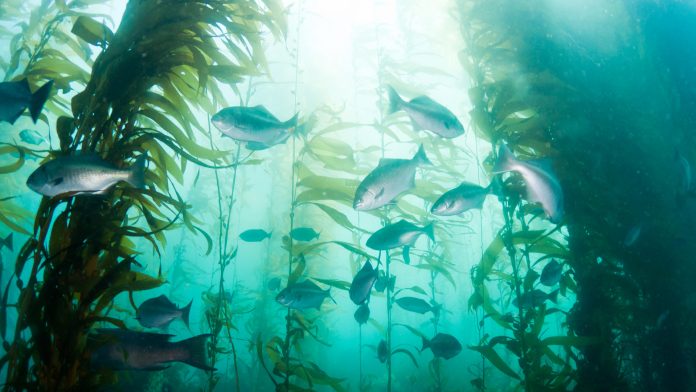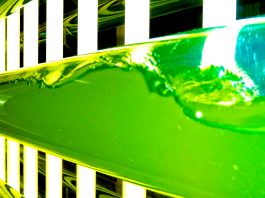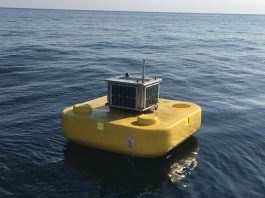The Innovation Platform’s Lorna Malkin spoke to Dr Adam Hughes, Marine Ecologist and Senior Lecturer at the Scottish Association for Marine Science (SAMS), about how aquaculture is evolving and the industry’s potential to contribute positively to the environment.
Aquaculture has experienced a huge expansion within the last 50 years, with fish now constituting the most traded food commodity in the world. The industry is an integral part of global food production and trade as well as a vital source of employment for many. Yet, with the global population expected to reach almost 10 billion by 2050, there is an increasing need for innovation within aquaculture if the industry is to satisfy global demand and reduce its impact on the environment.
The Scottish Association for Marine Science (SAMS) is an independent organisation which undertakes vital research to understand and improve the marine environment. As part of that research, SAMS looks at ways in which aquaculture practices could be modified to support the industry’s economic and environmental development. To find out more about emerging aquaculture industries and sustainable practices, The Innovation Platform’s Lorna Malkin spoke to Dr Adam Hughes, Marine Ecologist and Senior Lecturer at the Scottish Association for Marine Science (SAMS).
How has the aquaculture industry in Scotland changed in recent years? What changes have you seen in terms of finfish, shellfish and aquatic plant production?
Over the last decade in particular, the aquaculture industry has seen a real expansion. Salmon farming remains at the core of Scottish aquaculture and there has not been any great diversification there. In terms of finfish aquaculture, site selection has greatly improved and a lot of this type of farming now takes place slightly offshore, in more exposed areas. Although offshore farming can benefit the environment in terms of greater water movement, it also presents engineering challenges in terms of health and safety and the structural integrity of the pens. As less favourable sites have been removed, there has been a consolidation of those sites into larger farms. In terms of the scale of these farms, it has been incremental; for the first time, new regulations are allowing biomasses over 2,500 tonnes, but any increase in biomass is dependent on the environmental performance of the incremental increase. In terms of shellfish the greatest shift in Scottish aquaculture mainly relates to mussel production, and a lot of this production now takes place in Shetland.
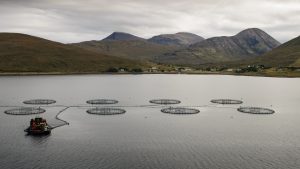
Another major shift we have seen in aquaculture is how the salmon industry deals with outbreaks of lice. Until recently, emamectin was the main in-feed treatment being used, but now we are seeing a diverse range of innovative solutions including biological controls like cleaner fish, alongside things like thermal treatments, stingray lasers, and barrier methods being employed. We have also seen better management of sea lice through the use of models and management at area level, as opposed to treating outbreaks on a farm-by-farm basis. The use of tarpaulins and snorkels also seems to be a really good solution. In Norway, they have developed the barrier idea into closed containment systems – the Egg, for instance, designed by Hauge Aqua.
Additionally, the size that fish are going to sea marks another big change. Ten years ago, the majority of fish would go out at smolt zero, or smolt half, which would be around 100g, but now it is quite common for 500g fish to go to sea. That means they spend less time in the marine environment and are less impacted by sea lice or other diseases. It also means there is quite a lot of innovation going on in terms of recirculating aquaculture systems to grow those smolts until they are that much bigger.
What conditions are needed for finfish aquaculture to thrive?
For finfish, it is all about water quality. As fish are being grown in an open environment, good water quality is absolutely paramount; it needs to be well oxygenated with good flow rates and contaminant free. It also needs to be free of lice and parasites, which is more of an issue in Scotland where farms are closely connected. The higher the energy environment, the larger the dispersal of all organic waste, which is good for the assimilative capacity of the environment to deal with it, but it also means it is spread further, and so the impact is greater.
For every fish farm that is consented, the impact on the seabed needs to be modelled. SAMS produces this dispersion model which is used to understand the footprint and how much material from that biomass ends up on the sea floor. Our recently updated NewDEPOMOD is a particle tracking modelling software used for environmental risk management, which is crucial. When we think about environmental sustainability, we often think of it as a binary thing – something that is either sustainable or not. However, it is more of a movable scale between those two points, and where we place our cut-off is determined by our understanding of the environmental risk. Therefore, if we can manage and model that environmental risk more effectively, we can better understand the impact that aquaculture is having on the environment. It is up to us as a society to say if that impact is acceptable, or if it is not.
SAMS has been looking at ways to help the industry reduce its environmental impact. Firstly, we have been doing work to model the connectivity between fish farms and outbreaks of lice, looking at how the position of farms can affect cross-contamination. In doing so, these models can help us design farm arrangements which incorporate firebreaks to prevent lice propagating all the way up the coast.
Another really interesting piece of work that SAMS is doing is looking at whether we can use environmental DNA (e-DNA), the microbiome of the environment around fish farms, to understand the impact that fish farms have on the sediments and the communities within those sediments. Traditionally, this is done by analysing macro invertebrates – the worms and the other animals which live in the sediments – using microscopes, but SAMS is investigating alternative methods involving DNA barcoding at the bacteria level. This is much more sensitive because that is where the initial changes happen and happen quickest. Carrying out analyses through next generation sequencing is a much quicker process than dissecting a sample.
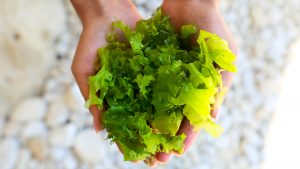
We are also researching integrated multi-trophic aquaculture (IMTA). The idea is that by growing seaweed and shellfish alongside the salmon cages you can intersect some of the waste streams that would otherwise settle on the seabed through the organisms either eating the particles or the seaweed taking up the inorganic nutrients. The most expensive ingredient in salmon feed is the protein, and this is released from the salmon farm as nitrogen. So, if you can capture some of that nitrogen and convert it back into a value, through seaweed, then you are reducing your environmental impact and potentially increasing the profitability of the farm.
Today, fish farms are heavily regulated; they have a certain allowable footprint, and if that footprint is bigger than what is stated within their licence condition, then they are in breach of their licence and there are measures that can be taken. It is possible that techniques such as IMTA, using real time monitoring or next generation sequencing, would allow the industry to be more responsive and so reduce its environmental impact.
In addition to environmental conditions, it is important for the industry to consider the social conditions, too. There is increasing opposition to fish farm applications and an increasing public perception that aquaculture is environmentally damaging. So, as well as a good environment, the industry needs to cultivate a good social acceptance.
Are there any key differences in the way salmon is farmed in Scotland and Norway?
The salmon farming industry in Scotland and Norway is very similar, as the farms are largely owned by multinational companies. In terms of innovation, Norway is leading the way with new cage designs and relocating fish farms offshore.
What are some of the latest advancements in aquaculture technologies?
The industry is highly innovative and it changes on a yearly basis. Over the last 50 years, aquaculture has gone from being a relatively small industry to producing half of the world’s seafood for human consumption. This huge growth is all built on innovation at one scale or another. If you look at any aspect of aquaculture in Europe, it is now a highly technological industry with high levels of technical expertise required. In terms of food production, you could say that aquaculture is possibly the most innovative sector.
There could always be more funding to aid innovation, of course, but I think there is a recognition now that aquaculture is globally important. You certainly get this sense in Scotland, where there is quite a lot of funding available for innovation. It is also important to remember that within companies, there is a lot of ongoing innovation that is not publicly funded. I therefore do not see a lack of funding as a bottleneck for innovation; there are probably other bottlenecks around close collaboration between academia and industry and creating a regulatory environment that is more conducive to innovation for the aquaculture industry.
In recent years, there has been an increase in the development of large-scale seaweed aquaculture, what has driven this increase in production?
In the global context, seaweed aquaculture is huge. Outside of Europe, we have seen a really rapid expansion of seaweed aquaculture. By species group, it is probably the largest form of aquaculture and is based mainly in Asia. Although there is a long history of aquaculture in places like Japan and Korea, much of the industry’s development has happened in the last 50 years due predominantly to food production or the manufacturing of bulk chemicals which are used in thickening agents – in toothpaste and shampoos as well as in food products.
In Europe, most of the seaweed industry is based around wild harvest. Instead of growing it, you go into the wild and harvest what is already there. Around 95% of the industry is wild harvest and 5% is aquaculture. Whereas if you look at the rest of the world, those figures are reversed – so 95% of seaweed is grown and 5% acquired through wild harvest. There is a great realisation that Europe, especially Northern Europe, has huge potential for growing seaweed, especially fast-growing kelps. The nutrient rich, cool waters and long days are ideal conditions for growing seaweed in northern climates in the UK, Norway, Iceland, and the Faroes, and this is being studied in EU projects such as AquaVitae. The seaweed aquaculture industry in Europe is much smaller than wild harvest, but there is potential for it to grow.
Determining the end uses for this seaweed produced in Europe will depend on how individual markets develop. If you think about what you can get out of seaweed in terms of a triangle of value, at the top of that triangle are nutraceutical or pharmaceutical products; then, below that, human food; and then you may have things like animal feed, bio energy, or bio plastics. At the moment, most seaweed aquaculture is centred on human food and cattle or horse feed, which is where the high value markets are. However, in Europe seaweed is not regularly eaten, and so we need to look at developing those markets so the industry can grow. And as the industry does develop, we can move down that value chain, developing markets for animal feeds and subsequently bioenergy or bio plastics, for instance.
Since so much of UK landmass is dedicated to agriculture, there is limited opportunity to increase food production on land so growing our own protein at sea is the next logical step. Similarly, there is an increasing movement towards vegetarianism and veganism as well as climate friendly and environmentally friendly food production systems, and seaweed certainly complements that. There is a range of drivers that suggest seaweed production will continue to expand and become increasingly important to the aquaculture industry, but we are only at the very beginning of that curve.
What are some of the benefits associated with the cultivation of seaweed?
There are a number of possible ways that seaweed aquaculture can benefit the marine environment. When we talk about IMTA for instance, seaweed takes up inorganic nutrients from the environment; all our coastal seas are nutrient rich, and probably have surplus nutrients due to our large urban populations and agricultural practices, so that means nitrogen from the land ends up in the sea. If we can remove that nitrogen by growing the seaweed and taking it out and eating it, or putting it on land, that, in turn, benefits our coastal environments. Additionally, when you put structures into the sea you create habitats, so it is possible to increase biodiversity locally by increasing the seaweed farms and the flow of seaweed to the other food webs. We need to do more research about how that actually happens, or whether it happens at scale.
Renewable energy is another area that seaweed could benefit. Growing seaweed for biofuels garnered a lot of interest about ten to 15 years ago and there are many reasons why it would be beneficial to the environment. Seaweed does not require freshwater, nutrient inputs, or land, so you create biomass relatively environmentally benignly. Seaweed also has a high sugar and carbohydrate content, making it amenable to anaerobic digestion as well as easy to ferment into alcohols. The pathways to energy production are relatively well understood and easy to do. However, following the economic crash, and the reduction of oil prices, biofuels started to look expensive, and still do, but there is now more interest in them as we endeavour to become carbon neutral.
We understand that we are going to have to move to net zero in a relatively short timeframe, so we need to look at our fuel mix. Electricity is obviously great for a lot of applications, but it does not meet all the energy demands and there is a need to diversify, possibly into liquid fuels or for specific applications. There is now an understanding that biofuels may play a role in that new energy mix and, if they do, there are inherent advantages to seaweed as a biofuel.
The other use for seaweed is as a chemical basis for biodegradable plastics production. Replacing the petroleum equivalent is expensive, but if you can do it for corn-starch bags, you can certainly do it for seaweed. You have to think about what you want your limited terrestrial environment to do, whether it is producing plastics or whether it is producing food. There is potential there, but it is a complicated picture of macroeconomics and a range of other factors, but it is feasible.
Dr Adam Hughes
Marine Ecologist and Senior Lecturer
Scottish Association for Marine Science (SAMS)
www.sams.ac.uk
Please note, this article will also appear in the sixth edition of our quarterly publication.

